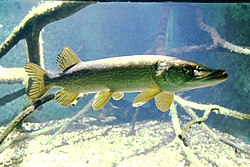Esox
Esox is a genus of fresh water fish. It is the only living genus in the family Esocidae. The oldest known example of an Esox is Esox tiemani.[1] It dates to about 62 million years ago and was found in Alberta, Canada.[1] They are commonly called pike and pickerel. They are found in the northern parts of North America, Europe and Asia.[2] One species, Esox lucius, the Northern pike, is found in both Europe and North America.[2] Esox are large predatory fish with a long cylindrical body. They have a green color (various shades) with yellow eyes. Pike and pickerel share a forked tail fin and a large pointed head.[2] Their dorsal and anal fins are located far back on their bodies.[2] All species have very sharp teeth.
| Esox | |
|---|---|

| |
| Northern pike (E. lucius) | |
| Scientific classification | |
| Kingdom: | |
| Phylum: | |
| Class: | |
| Order: | |
| Family: | |
| Genus: | Esox |
| Type species | |
| Esox lucius | |
Species
Currently there are five species in the Esox genus. The study of this family is not complete. There are several known hybrids between species which occur naturally.[3] The five species are:
- Esox lucius - The northern pike; found in both Eurasia and North America.[4]
- Esox reichertii - The Amur pike; found in the Amur river in Asia.[4]
- Esox masquinongy - The Muskellunge; found in northern and eastern North America.[4]
- Esox niger - The Chain pickerel; native to the U.S. states of Georgia and North Carolina.[4]
- Esox americanus - The redfin pickerel; also found in Georgia and North Carolina.[4]
There is an extinct species called Esox tiemani.
Forage
All species of Esox are predatory feeders.[5] They eat other fish, small mammals and birds.[5] Pike will eat almost anything that doesn't eat them first.[6]
Esox Media
A young E. lucius specimen — a "chain pickerel" in the original sense — in an aquarium.
Fossil specimen of Esox lepidotus
Fossil specimen of Esox kronneri, the earliest known pickerel
Pike in Haus des Meeres, Vienna
References
- ↑ 1.0 1.1 Joseph S. Nelson, Fishes of the World (Hoboken, NJ: John Wiley & Sons, 2006), p. 205
- ↑ 2.0 2.1 2.2 2.3 Lawrence M. Page; Brooks M. Burr, Peterson Field Guide to Freshwater Fishes of North America North of Mexico (Boston: Houghton Mifflin Harcourt, 2011), p. 60
- ↑ Pike: Biology and Exploitation ed. John Craig (London: Chapman & Hall 1996), p. 2
- ↑ 4.0 4.1 4.2 4.3 4.4 Fishes of the Middle Savannah River Basin: With Emphasis on the Savannah , ed. Barton C. Marcy (Athens, GA; London: University of Georgia Press, 2005), p. 241
- ↑ 5.0 5.1 Mark Everard, Britain's Freshwater Fishes (Princeton: Princeton University Press, 2013), p. 94
- ↑ Vin T. Sparano, The Complete Outdoors Encyclopedia (New York: Thomas Dunne Books/St. Martin's Griffin, 2000), p. 482
Other websites
- University of Esox Archived 2014-06-13 at the Wayback Machine
- Northern Pike, Esox lucius
- Chain Pickerel Esox niger Archived 2014-07-02 at the Wayback Machine
- Redfin pickerel Archived 2013-10-30 at the Wayback Machine
- Amur pike in Russia





